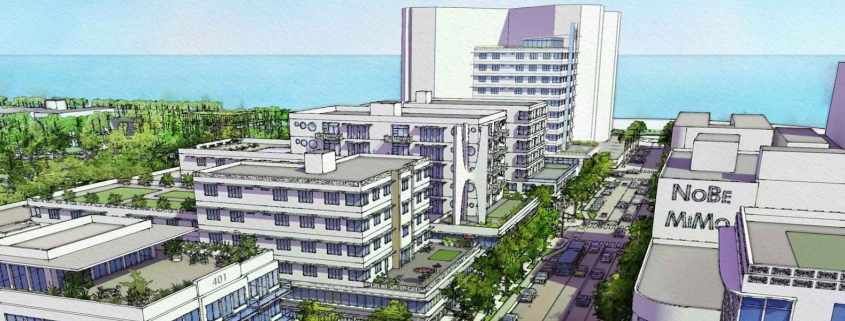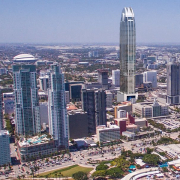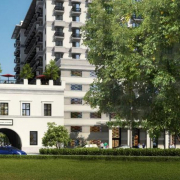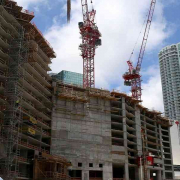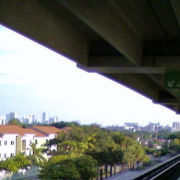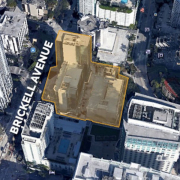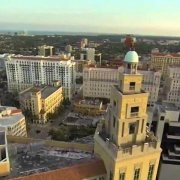North Beach’s new main street might include tiny apartments, 200-foot towers and homes that double as businesses.
This vision for the “Town Center” area along 71st Street, developed by city planners, is designed to turn a stretch of the island that has seen little development into a hub where residents can live, work, shop and eat without ever getting into a car.
“We think that there’s an opportunity to make Town Center more walkable and more liveable and we want to see Town Center thrive,” said Thomas Mooney, Miami Beach’s planning director. “We wanted to have more of a 24-hour feel.”
Mooney and his team have proposed allowing developers to build up to 200 feet if they provide a public benefit, such as affordable housing or a contribution to a fund that could be used for a variety of neighborhood projects. He said limiting the height to 12 stories (125 feet), which was recommended in the master plan for North Beach, would generate “static” buildings and wouldn’t leave much room for creativity.
“We wanted to build in the ability for a good architect to be able to creatively redistribute” the allowed density in a taller structure, Mooney said.
In addition to allowing micro-units — tiny, furnished apartments in buildings with shared amenities — city planners have recommended permitting artisanal retail where goods like artwork, food and beer are produced and sold on-site and neighborhood fulfillment centers where shoppers can pick up goods they order online. Units where residents can live and work in the same space would also be allowed.
But not everyone agrees with this vision for Town Center.
The redevelopment of the area between Collins Avenue and Indian Creek Drive/Dickens Avenue from 69th Street to 72nd Street was approved by voters last November when they authorized an increase in density. Voters approved an increase in the overall size of buildings in the area, but the referendum didn’t get into specifics. That was left up to the city’s planning department.
Some residents object to allowing 200-foot towers and are skeptical about the micro-units, which they say will only attract tourists. (Short-term rentals are legal in the Town Center area.)
North Beach activist Kirk Paskal said 200-foot towers weren’t what voters envisioned when they cast their ballots because the height increase hadn’t been included in the master plan or agreed to by residents.
“Now suddenly, this new urgency for more height could severely damage the character of North Beach in a drastic and permanent way,” Paskal said in an email. “Any public benefits that may be proposed by way of this last minute effort to stray from the plan, could not justly recompense the harm that would be inflicted on the alluring human scale and cohesive character of North Beach by the incompatible and oppressive height of 200 feet.”
Paula King, a longtime North Beach resident, also has concerns about the maximum height.
“What they’re looking for is to build these high needles that are higher than any other building in North Beach so they can have the view and charge more for it,” King said. “Miami Beach is not New York. We don’t have the infrastructure to support this.”
Tiny Living
Micro-units are a trend in urban areas among residents who are willing to trade space for the opportunity to live in a neighborhood they couldn’t otherwise afford. Projects have sprouted up in Wynwood and downtown Miami, as well as in Miami Beach. A new micro-unit project at 6080 Collins Ave. offers apartments as small as 350 square feet, about the size of two parking spaces. Other micro-unit projects are in the works on South Beach’s Washington Avenue.
Mooney and his team have proposed allowing micro-units in hotels and apartment buildings in Town Center as long as the building includes plenty of shared amenities like community kitchens, business centers and gyms.
Commissioner Kristen Rosen Gonzalez is skeptical the micro-units will appeal to North Beach residents, however.
“What you have right there is a massive amount of transient tourism,” Rosen Gonzalez said. “It really is not reflective of what the community wanted,” she added, referring to the micro-units and the proposed height limits. “We can’t turn North Beach into South Beach.”
Others disagree. In order to attract young people and plan for the future, the regulations forTown Center need to leave room for new housing trends, said Commissioner Ricky Arriola.
“I think we need to be open minded and flexible,” Arriola said. “We can’t be rigid and just stick to the way we’ve always done things. The facts are that we are losing our millennial generation across the bay.”
North Beach residents have mixed views on the proposals.
Miguel Gonzalez, 36, said he wasn’t sure there is a market for micro-units right now due to a lack of job opportunities and public transportation. But Gonzalez, a lawyer who lives within walking distance of Town Center, said that could change.
“If you could work and live in the same place, like in downtown Miami, if they can convert this into that kind of area, more young people might be interested,” Gonzalez said.
Judith Acame, 77, lives in the Town Center area and said she thought the micro-units would appeal to young people, but not to low-income retirees like her.
“People my age will have to move to cheaper areas,” Acame said in Spanish.
Acame said she loves living in the neighborhood because she can walk to her yoga and Tai chi classes and to a nearby senior center. If the area gets more expensive and fills with buildings catering to young people.
“I guess I’d have to go to Hialeah, where my brother lives,” Acame said.
Ultimately, the city will have to be flexible in order to attract economic development to North Beach, said Commissioner John Elizabeth Alemán.
“North Beach’s Town Center District has seen little new development since the concept originated in 2003,”Alemán said in an email. “This time around, it is imperative that the Commission err on the side of growth and progress. The North Beach community craves results.”
The planning department’s proposal, included in the draft of an ordinance that will regulate area development, will be evaluated by the city’s planning board on July 24 and by the Land Use and Development committee on July 31. The City Commission will have final say.
The draft ordinance includes a number of other proposals, including provisions to ensure ample space between towers so that air and light filter down, limits on the numbers of hotel rooms and apartments, and noise reduction requirements for businesses that provide entertainment.
Source: Miami Herald

